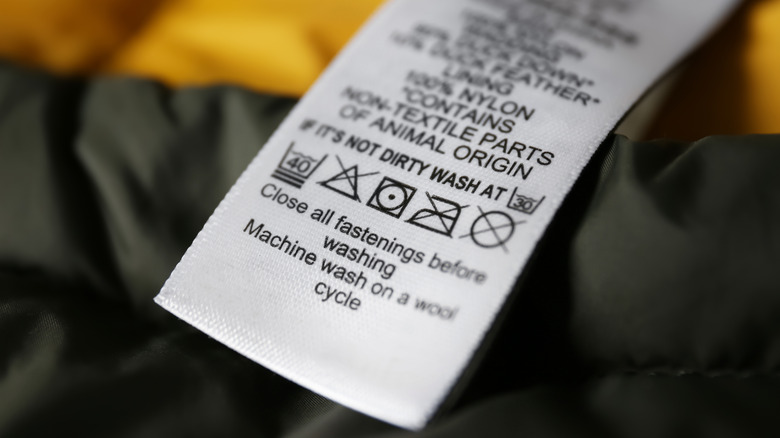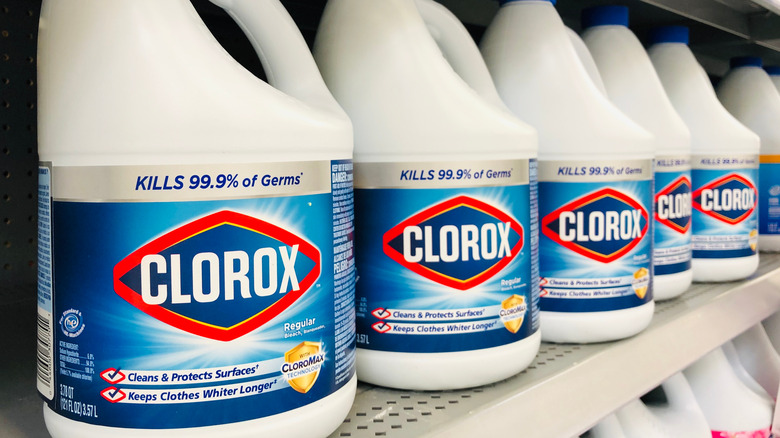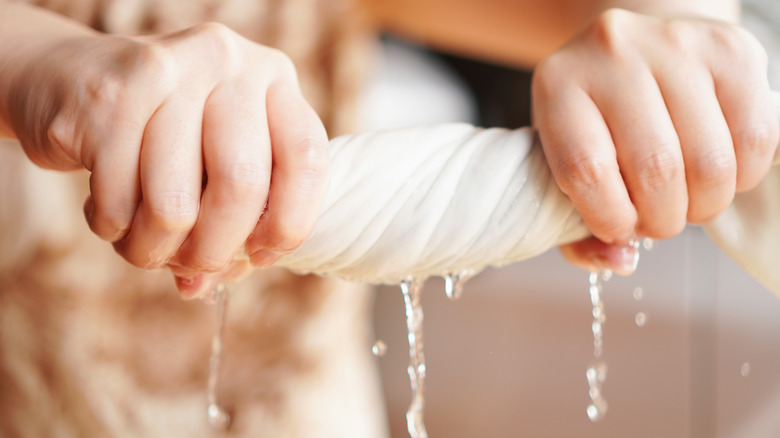Your Guide To Laundry Codes So You'll Know How To Clean Everything The Right Way
In many ways, laundry has become much easier with the invention and progression of washing machines and dryers, detergents and soaps that prevent color bleeding, and other advancements. That being said, each piece of clothing item has its own specific care needs, so you must still be mindful during the washing process. When running a load of laundry, you may have noticed the tags on clothing or linens with various symbols. While many instruct the temperature, speed, and colors to accompany the item, some go even further.
According to GINETEX Switzerland, these symbols, called care labels, were invented in the 1960s as a response to the popularity of synthetic fibers, which made the laundry process more complicated. Care labels and laundry codes became an international standard in 1970 as global trade became increasingly popular. While they help you properly care for your clothing, it can be confusing to know what the symbols and codes mean. Keep reading for a breakdown of a few of the most common codes.
Washing machine guide
If you're starting a load of laundry, the first symbol you should look for is the small tub, which indicates that the item can be machine washed, explains IHateIroning. That is unless the tub has an "X" over it, meaning it should not be put in a washing machine. The dots in the tub indicate the temperature they should be cleaned. For example, Tide says that one dot indicates the item should be washed on a cold setting, two dots means warm, and three dots means hot. But there may be a number indicating maximum temperature instead.
There may also be lines under the tub, which show the speed at which the garment can be spun. If there isn't a bar, run your washing machine on a regular spin cycle. One bar means the speed should be reduced to a permanent press setting, and two bars indicate the need for a gentle or delicate cycle.
Dryer codes
Next in the laundry process is drying your clothes, which has its own set of laundry codes. The dryer symbol will look like a square with a circle in it. Dots, crosses, and other variations to the character change what it means, though. If the whole symbol has a cross through it, for example, you should not tumble dry it, per SuperSavvyMe.
If there is one dot in the circle, that indicates your laundry can be dried on low heat, two means medium heat, and three dots means it can handle up to high heat, according to Tide. If the circle is solidly filled in, it can be tumble-dried with no heat. If it says not to tumble dry, the tag will tell you what you should do. There will also be a square to indicate this. If there's an envelope shape or a small half circle towards the top, you should line dry the garment. Three vertical lines mean you should let it drip dry, and one horizontal line means you should lay it flat.
Ironing symbols
Now that your laundry is clean and dry, you may need to iron them. While some materials like cotton are pretty straightforward when it comes to ironing, more fragile textile blends should be treated a bit more carefully. Luckily, most garments have laundry codes that indicate how, if at all, the clothing item should be ironed. This symbol is easy enough to spot, as it looks like an iron.
As with the washing and drying care labels, there will be dots inside the iron symbol indicating the temperature it should be ironed. According to PlanetCare, one dot means the garment can be ironed, but it should be done at a low temperature. Next is two dots, which means it can handle a medium temperature, and last is three dots, which convey that the iron can take a high heat setting. If the iron symbol has an "X" through it, you should not iron the item at all. If it has three lines at the bottom and an "X," that means you can iron it, but you should not use the steam setting.
Bleach guidelines
If your laundry items have a stain, you should consult the tag to see if you can use bleach to get it out, and if so, what kind. Bleach will be represented by a triangle, per PlanetCare. This is one of the most straightforward care label codes out there. If the triangle is crossed out, you should not use any bleach on the item.
If the triangle is empty, you can and should use any bleach — chlorine or non-chlorine — with each load. Lastly, if the triangle has two diagonal lines, you can use non-chlorine bleach on the garment only when needed. If you have an item that requires bleach for regular care, consider using a non-chlorine-based bleach unless there's a heavy stain or it needs disinfecting. Chlorine bleach is worse for the environment, so a less harsh option for regular maintenance is ideal.
Hand washing and dry cleaning
If your clothes can't be machine washed, they can be hand washed or dry cleaned. Again, the care label will indicate which one is appropriate for your garment. The symbol for hand washing will be the same for machine washing, but with a hand, per IHateIroning. Delicate materials, such as silk or cashmere prone to pilling or shrinking, will likely have this symbol. If there's a twisted, candy-shaped symbol, you can wring out the clothing, and if there's the same symbol with an "X," you cannot.
If your item can only be dry cleaned, this will be indicated by a thick circle symbol. Everything else involved with the circle is a guide for the dry cleaners on what chemicals to use, how delicate it is, etc. If there is an X through the circle, it shouldn't be dry-cleaned. Other than that, the letter inside states what chemical to use, and the lines underneath indicate how fragile it is — more lines mean more delicate.





